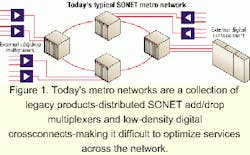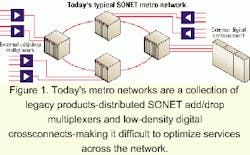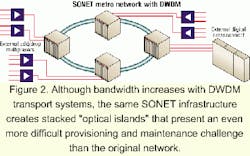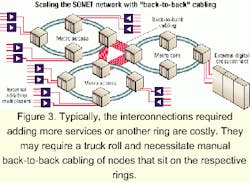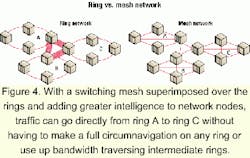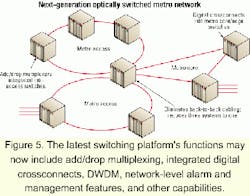Gaining the edge in flexible metro service provisioning
Today's network architects demand a transition from traditional transport infrastructures to dynamic switch-based services and light paths.
BY JIM MOONEY, Sycamore Networks
Built throughout the 1980s and 1990s, today's existing SONET ring-based metropolitan infrastructure was designed to support fixed 64-kbit/sec voice connections with their highly predictable traffic patterns. Although static and rigid, the SONET architecture worked well for delivery of traditional telephony services. Modeling and accommodating voice traffic flows had been refined to a science, resulting in a service delivery business that offered relatively few challenges or capacity surprises-until the Internet and other high-bandwidth services came along and completely changed the game.
Today, service providers face some significant challenges, especially in the metropolitan-area network where the majority of these bandwidth-hungry services originate. In fact, services like the Internet, video transport, interactive gaming, and streaming media are creating unprecedented demand for fatter, faster, less-expensive bandwidth services. While providers scramble to keep up with demand, the reality is that today's SONET-based metro networks are ill-equipped to handle the evolving dynamic and diverse traffic streams.
Today's metro networks are a collection of legacy products-distributed SONET add/drop multiplexers and low-density digital crossconnects-making it difficult to optimize services across the network (see Figure 1). The services carried on this network flow across dedicated "hand-stitched" circuits that are costly and time-consuming to provision.A common solution to today's bandwidth crunch in the metro is to add more bandwidth in the form of discrete wavelengths by deploying DWDM transport systems (see Figure 2). These solutions are available from a number of vendors. But what sounds like a simple solution to the bandwidth shortage often creates even more difficulties, because now there are multiple layers of rigid, inflexible rings. There's more bandwidth, but with the same SONET infrastructure, which creates stacked "optical islands" that present an even more difficult provisioning and maintenance challenge than the original network.
The Internet's dynamic and bursty data traffic, coupled with the need to quickly scale and reconfigure networks to handle the torrent of services that come with increased user demand, points out some significant shortcomings of today's SONET-based backbones and rigid, ring-based transport topologies. While DWDM helped by adding raw capacity, it did nothing to address the requirements of rapidly provisioning services and routing traffic along the most efficient path.
Incorporating switching intelligence gives service providers the ability to transform the existing fiber-optic network from an inflexible transport medium into an intelligent network foundation for high-speed service delivery. The ever-changing requirements of today's network users demand a transition from inflexible transport infrastructures to dynamic switch-based services and light paths.
That's especially true in the areas of metro access and metro core, collectively designated as the network edge. It is at the network's edge where traffic fluctuations can be greatest and for which ring-based metro networks, often-isolated islands of optical networking, are particularly inadequate for scaling and transporting traffic across multiple networks.
These optical islands are fine for traffic that only has to travel along the same ring to reach its destination. They can take in bits from a particular location, map it to a circuit or wavelength, and transport it to another location on the ring to be dropped off. But getting beyond this rather elementary level of functioning-to a more flexible and dynamic network that can provide a variety of end-to-end services-requires the great leap forward that switching provides.
Demand from customers for real-time, end-to-end service provisioning and improved bandwidth capacity and efficiency has emphatically underlined the weakness of today's ring-based metro networks and metro DWDM transport solutions. The hierarchical and inflexible nature of these solutions makes interconnecting these optical islands an operations and management nightmare.Typically, the interconnections required to add more services or another ring are made costly by the necessity to dispatch a truck roll and performing manual back-to-back cabling of nodes that sit on their respective rings (see Figure 3). Although these nodes are often collocated, their interconnection can still represent a logistical and administrative challenge that can take weeks, if not months, to complete. While connecting with only one other ring can easily be an ordeal, interconnecting a large number of rings can mean facing an "n-squared" interconnection challenge-unless providers have intelligent switching platforms in place at the edge that permit software-based dynamic connections when necessary.
Perhaps the ultimate test of switching platforms and overall network intelligence for the metro optical market is how hands-on providers aren't required to manage that network.
To date, service provisioning has been a time-consuming, serial process of physically cabling and crossconnecting nodes, along with adjusting optical hardware elements, to tune the network and manage traffic flows. But the goal of software-based, point-and-click provisioning is now within reach of any service provider-and even their customers.
A new generation of network-management software is providing a view of the entire network to monitor its health and direct its performance in real-time. This advance is revolutionizing management functions on the network from the backbone out to ring-based metro access and metro core networks. Each ring once existed as a different management domain, requiring individual provisioning of circuits on each ring and executing multiple crossconnects to hand-stitch an end-to-end service. This multistep process can require months to complete and take a toll on customer patience and provider revenues.
Now, intelligent optical metro-edge switching platforms and network-management software are making the same provisioning possible remotely and in seconds. These platforms include all the alarm and performance information needed to ensure networks are operating as promised.
In addition to the challenges faced with interconnection and service provisioning, an additional problem for today's unsophisticated metro networks is their inability to efficiently utilize bandwidth across the network. The problem generally manifests itself when a particular service or port on a card is mapped to a particular wavelength that has more capacity than is required by the service or port in question. The result is wasted bandwidth and a lost profit opportunity. For example, because Gigabit Ethernet service runs at 1 Gbit/sec, mapping that service to a dedicated ring wavelength running at 2.5 Gbits/sec winds up being a very inefficient use of that channel. It is also one that's unavoidable given the relatively crude control that conventional ring-network technology provides for mapping data streams to bandwidth.
Incorporating a switching platform with highly granular control over its wavelengths changes that picture entirely. With it, a second Gigabit Ethernet service, multiple DS-3 (44.736-Mbit/sec) private lines or OC-3 (155-Mbit/sec) wave services can be added and run simultaneously on the same OC-48 (2.5-Gbit/sec) wavelength to maximize utilization. That creates a much more efficient high-speed on-ramp to the optical core.
While other solutions "burn waves" using a wavelength per single service or use additional DWDM/SONET equipment to multiplex multiple services onto a higher-speed line, more innovative switching platforms can combine multiple services onto one wavelength without costly external equipment. This method of "sharing a wave" provides the most efficient, most manageable, and most cost-effective solution to the demands of a mixed-service, high-demand network.
Service interruptions are always possible on the network. A common insurance policy to avoid a total interruption of communication services involves reserving a costly second wavelength for backup and mapping a predetermined alternative route as a fail-safe for end-to-end network protection. But to do that, users pay twice the cost for only half the bandwidth. This 1+1 protection scheme is a very traditional, ring-based method to restore the circuit or wavelength. It is also a highly wasteful strategy, if users have to pay for protection circuits they ultimately don't need.
Because conventional service restoration techniques tend to be ring-based, they are adequate for healing/reconfiguring service within an optical island. But most users are not asking to be connected between buildings within a metro access ring. More often, they are connecting to a remote office in another city. Restoring data flows across several rings to reestablish end-to-end service becomes a more complex endeavor made possible only with an intelligent switching solution to restore the network.
There is movement underway by industry groups to create dynamic routing and signaling standards. These standards, and the switching platforms that incorporate them, will allow more intelligent, mesh-oriented restoration, regard less of where in the network the failure takes place. This restoration will occur by having system-wide intelligence that takes the full connection into account rather than only focusing on network interruptions one problem-and one ring-at a time.
The contrast in efficiency between transport-based and switched networks is significant. In addition to intelligent switching eliminating the need for reserved backup bandwidth for restoration, re-routing traffic flows due to network problems can be handled much more efficiently. With conventional ring networks, for example, three interconnected rings without switching-A, B, and C (see Figure 4)-will waste a lot of bandwidth and time getting traffic from ring A to ring C. Traffic in ring A heading for ring C must make a complete circuit on A before being offloaded to ring B. Once on ring B it must take another complete lap before being deposited on ring C. With a switching mesh superimposed over the rings and adding greater intelligence to network nodes, however, traffic can go directly from A to C without having to make a full circumnavigation on any ring or taking up bandwidth while traversing intermediate rings.With intelligent switching introduced in all of the backbone and into metro access network nodes, providers can expect a granularity of control that allows analysis of each circuit, on a circuit-by-circuit basis, for routing and restoration purposes. From that broader perspective and control will come improved decision-making on the most appropriate action to take for traffic management and end-to-end restoration.
The return on investment for implementing a switched metro network will vary depending on whether it is a greenfield site or an established service provider. But all will benefit from the reduced complexity that switched networks deliver by integrating several functions-once requiring multiple boxes on the network-combined into a single switching platform. The latest switching platform's functions may now include add/drop multiplexing, integrated digital crossconnects, DWDM, network-level alarm and management features, and other capabilities (see Figure 5).Yet another source of savings comes from the increasingly compact size of these multitalented switching platforms. Because they are integrating so many functions into such a small physical footprint, these edge switches are delivering substantial cost reductions by minimizing the amount of floor space that has to be rented in central offices and carrier hotels.
Evidence indicates that optical edge switches now available are producing operational savings for some carriers of between 40% and 50% annually. Economies from integration and miniaturization are making possible cost-effective switching platforms targeted for the network's edge.
While they served their purpose-and served well-for a long time, the metro market's traditional ring-based networks are rapidly evolving into switched mesh and logical mesh systems in the face of demanding customers who require better and more flexible service offerings. From dynamic connections and real-time provisioning to intelligent restoration and end-to-end services, providers are recognizing the optical edge switch as the coming of the next generation in optical-network equipment.
Jim Mooney is vice president of product marketing for the optical edge business unit at Sycamore Networks Inc. (Tewksbury, MA).
